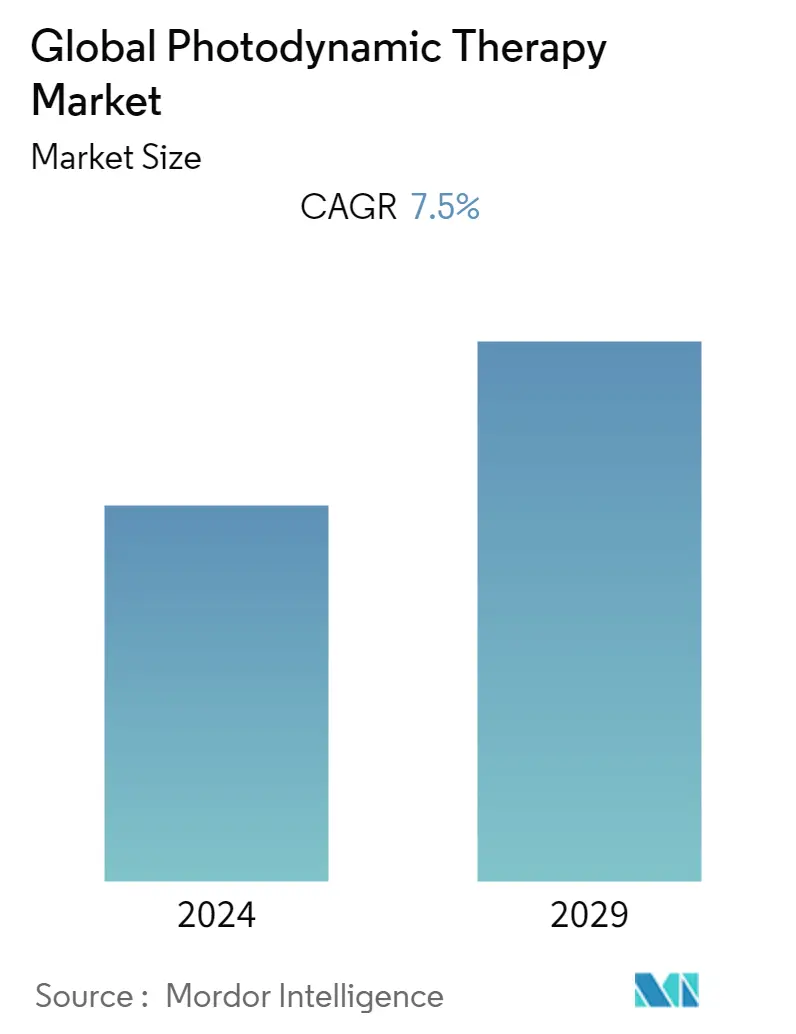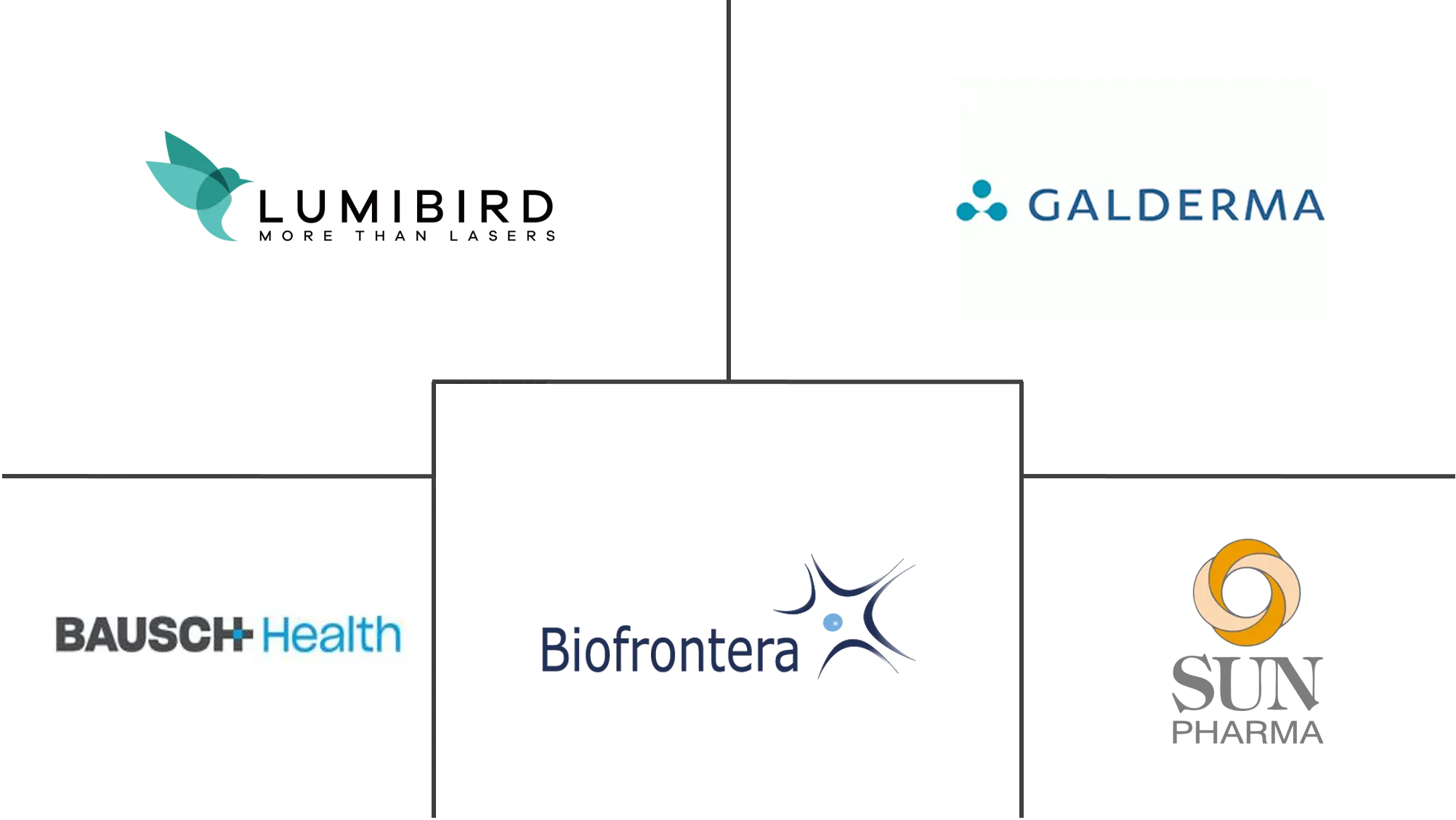Market Size of Global Photodynamic Therapy Industry

| Study Period | 2019 - 2029 |
| Base Year For Estimation | 2023 |
| Forecast Data Period | 2024 - 2029 |
| CAGR | 7.50 % |
| Fastest Growing Market | Asia Pacific |
| Largest Market | North America |
Major Players
*Disclaimer: Major Players sorted in no particular order |
Photodynamic Therapy Market Analysis
The Photodynamic Therapy Market is projected to register a CAGR of 7.5% during the forecast period (2022-2027).
Cancer cells have been treated using photodynamic therapy, which also inactivates viruses and other infections. The photodynamic therapy (PDT) method has recently grown in popularity. Photodynamic therapy (PDT) as an alternative or complementary treatment for COVID-19 has been introduced as part of the search for alternative therapeutic techniques for the efficient management of COVID-19. For instance, as per an article titled 'Photodynamic disinfection of SARS-CoV-2 clinical samples using a methylene blue formulation' published in March 2022, to render SARS-CoV-2 inactive, photodynamic disinfection (PDI) was proposed, along with its therapeutic application to COVID-19 patients. It has been emphasized that PDI is a good candidate for treating COVID-19 because SARS-CoV-2 is an enveloped RNA virus, and these viruses are most sensitive to PDI.
The rise in prevalence of cancer and skin disorders, the demand for minimally invasive procedures, and the rising financial burden of cancer are anticipated to drive the expansion of the global market for photodynamic therapy. The market is being driven by increased consumer knowledge of the advantages of photodynamic therapy and an increase in the use of treatments for acne, eyes, and the face. Furtermore, growing R&D in photodynamic treatment analysis is opening attractive commercial potential. The increase in demand for photosensitizer drugs and equipment used in the treatment of different types of cancer is anticipated to propel the growth of the photodynamic therapy market. According to World Health Organization (WHO), Key facts updated in February 2022, cancer is a leading cause of death worldwide, accounting for nearly 10 million deaths in 2020, or nearly one in six deaths. Thus, the increasing prevalence of cancer cases across the globe is expected to rise the demand for photosensitizer drugs, thereby accelerating the market. As per an article titled 'Actinic Keratosis Risk Factors' published by Skin Cancer Foundation in January 2022, actinic keratosis (AK) is a skin precancer and has a presence across the globe and much in regions near the equator. Actinic keratosis is most frequently brought on by prolonged, unprotected exposure to UV light. The increasing prevalence of actinic keratosis is expected to boost the demand for photodynamic therapy for the treatment & care of actinic keratosis.
However, the high cost of photodynamic therapy and the risk and side effects associated with the therapy is expected to restrain the growth of the market during the forecast period.
Photodynamic Therapy Industry Segmentation
As per the scope of the report, photodynamic therapy refers to the destruction of abnormal cells using photosensitive medicine along with a light source. It is used in a variety of cancerous and pancreatic conditions. For skin cancers, the drug is placed on the skin or near the skin. For other types of cancers, the drug is given through IV infusion. The Photodynamic Therapy Market is Segmented by Product (Photosensitizer Drugs, Photodynamic Therapy Devices), by Applications (Cancer, Actinic Keratosis, Acne, Psoriasis, and Others), by End-User (Hospitals, Cancer Treatment Centers, Cosmetic and Dermatology Clinics and Others) and Geography (North America, Europe, Asia-Pacific, Middle East & Africa, and South America). The market report also covers the estimated market sizes and trends for 17 different countries across major regions, globally. The report offers the value (in USD million) for the above segments.
| By Product | ||||||
| ||||||
|
| By Applications | |
| Cancer | |
| Actinic Keratosis | |
| Acne | |
| Psoriasis | |
| Others |
| By End-User | |
| Hospitals | |
| Cosmetic and Dermatology Clinics | |
| Others |
| Geography | ||||||||
| ||||||||
| ||||||||
| ||||||||
| ||||||||
|
Global Photodynamic Therapy Market Size Summary
The photodynamic therapy market is experiencing significant growth, driven by the increasing prevalence of cancer and skin disorders, alongside a rising demand for minimally invasive procedures. This therapeutic approach, which involves the use of photosensitizers activated by light to destroy cancer cells, is gaining traction as an alternative or complementary treatment for various conditions, including COVID-19. The market is further propelled by heightened consumer awareness of the benefits of photodynamic therapy and advancements in research and development aimed at discovering new photosensitizers to enhance clinical outcomes. The growing application of this therapy in treating different types of cancer, such as breast and lung cancer, is expected to fuel market expansion.
North America is anticipated to lead the photodynamic therapy market, supported by the presence of key industry players, a high adoption rate of new biologics for cancer treatment, and a surge in product approvals by regulatory bodies like the United States Food and Drug Administration. The region's market growth is also bolstered by the increasing number of cosmetologists offering photodynamic therapy and the rising incidence of actinic keratosis. Despite the promising growth prospects, the market faces challenges such as the high cost of therapy and potential side effects. The competitive landscape is characterized by several major players, including BIOFRONTERA AG, Lumibird (Quantel Medical), and Sun Pharmaceutical Industries Limited, who are actively involved in product development and clinical trials to maintain their market positions.
Global Photodynamic Therapy Market Size - Table of Contents
-
1. MARKET DYNAMICS
-
1.1 Market Overview
-
1.2 Market Drivers
-
1.2.1 Growing Prevalence of Cancer Around the World
-
1.2.2 Advancements in Device Technologies
-
-
1.3 Market Restraints
-
1.3.1 High Cost of Photodynamic Therapy
-
1.3.2 Risk and Side Effects Associated With The Therapy
-
-
1.4 Porter's Five Force Analysis
-
1.4.1 Threat of New Entrants
-
1.4.2 Bargaining Power of Buyers/Consumers
-
1.4.3 Bargaining Power of Suppliers
-
1.4.4 Threat of Substitute Products
-
1.4.5 Intensity of Competitive Rivalry
-
-
-
2. MARKET SEGMENTATION
-
2.1 By Product
-
2.1.1 Photosensitizer Drugs
-
2.1.1.1 Aminolevulinic Acid
-
2.1.1.2 Porphyrin Derivatives
-
2.1.1.3 Chlorines
-
2.1.1.4 Others
-
-
2.1.2 Photodynamic Therapy Devices
-
2.1.2.1 Diode Lasers
-
2.1.2.2 Disposable Fiber Optic Light Delivery Devices
-
-
-
2.2 By Applications
-
2.2.1 Cancer
-
2.2.2 Actinic Keratosis
-
2.2.3 Acne
-
2.2.4 Psoriasis
-
2.2.5 Others
-
-
2.3 By End-User
-
2.3.1 Hospitals
-
2.3.2 Cosmetic and Dermatology Clinics
-
2.3.3 Others
-
-
2.4 Geography
-
2.4.1 North America
-
2.4.1.1 United States
-
2.4.1.2 Canada
-
2.4.1.3 Mexico
-
-
2.4.2 Europe
-
2.4.2.1 Germany
-
2.4.2.2 United Kingdom
-
2.4.2.3 France
-
2.4.2.4 Italy
-
2.4.2.5 Spain
-
2.4.2.6 Rest of Europe
-
-
2.4.3 Asia-Pacific
-
2.4.3.1 China
-
2.4.3.2 Japan
-
2.4.3.3 India
-
2.4.3.4 Australia
-
2.4.3.5 South Korea
-
2.4.3.6 Rest of Asia-Pacific
-
-
2.4.4 Middle-East and Africa
-
2.4.4.1 GCC
-
2.4.4.2 South Africa
-
2.4.4.3 Rest of Middle-East and Africa
-
-
2.4.5 South America
-
2.4.5.1 Brazil
-
2.4.5.2 Argentina
-
2.4.5.3 Rest of South America
-
-
-
Global Photodynamic Therapy Market Size FAQs
What is the current Global Photodynamic Therapy Market size?
The Global Photodynamic Therapy Market is projected to register a CAGR of 7.5% during the forecast period (2024-2029)
Who are the key players in Global Photodynamic Therapy Market?
BIOFRONTERA AG, Lumibird (Quantel Medical), Sun Pharmaceutical Industries Limited, Galderma S.A. and Bausch Health Companies Inc. are the major companies operating in the Global Photodynamic Therapy Market.

